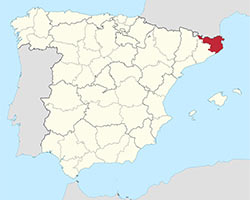Girona in Girona

Girona is Catalonia’s northernmost province, it borders on the provinces of Barcelona and Lérida, on France and the Mediterranean Sea. Girona also has a small exclave surrounded by French territory, Llivia, which covers a territory of 12.83 km2 and has 1,665 inhabitants.
The highest point in the province of Girona is Puig Pedrós at 2,914 m, situated in the Catalan Pyrenees.
The province’s greatest claim to fame is undoubtedly the Costa Brava (the Wild Coast) which stretches 214 km from Blanes in the south to Port Bou on the French border in the north. The wild rocky beauty of this coastline turned it into one of the first tourist areas when foreigners began to discover the charms of Spain. Today, the majority of the small, traditional fishing villages have turned into busy tourist resorts with high-rise buildings and noisy music pounding throughout the night.
But there are still unspoilt beauty spots to be found and quiet coves that will take you back to the Spain that first attracted foreign visitors.
Girona province covers an area of 5,910 km2 and is home to 755,715 souls (2017), 99,013 of which are to be found in its capital of the same name.
Sadly, Girona city situated where it is, close to France, Barcelona and the Costa Brava, it tends to be a place people pass through on their way somewhere else. This is completely unfair as it is a beautiful city in its own right with no end of fascinating and interesting features and areas.
Just like Cuenca, Girona is famous for its ‘casas colgantes’, hanging houses, which in this city are hanging out over water rather than over a deep gorge. They are sat on the river Onyar, and they have been painted in beautiful pastels. One of the many bridges that cross the river in that area was constructed by Gustave Eiffel‘s company, and when you go there, there will be no prize for guessing which!
 Girona’s Jewish quarter, El Call, dates back to the middle ages and it is one of the best preserved of its kind, not only in Europe, but in the world! Girona’s Jews co-existed peacefully with Moors and Christians for centuries and the community thrived. However, during the Inquisition the Jewish population had to renounce their faith or leave, like everywhere else in Spain. But the medieval quarter has been preserved, and it is a labyrinth of steep and narrow streets; here and there you will find small patios that let in the light, and the ambiance feels like it would have been 500 years ago.
Girona’s Jewish quarter, El Call, dates back to the middle ages and it is one of the best preserved of its kind, not only in Europe, but in the world! Girona’s Jews co-existed peacefully with Moors and Christians for centuries and the community thrived. However, during the Inquisition the Jewish population had to renounce their faith or leave, like everywhere else in Spain. But the medieval quarter has been preserved, and it is a labyrinth of steep and narrow streets; here and there you will find small patios that let in the light, and the ambiance feels like it would have been 500 years ago.
The Arab baths are also worth mentioning as well as the Rambla de la Libertad with its arched pavements and its weekly flower market, when the whole area is an explosion of colour and fragrance.
The climate in Girona is warm in summer and temperate in winter with variable spring and autumn temperatures. There isn’t a dry season as such, although the rainfall is much sparser in summer than during the rest of the year.
Girona takes its gastronomy very seriously, and there are no less than 20 Michelin stars to be found in the province as a whole, distributed on 15 establishments. El Celler de Can Roca, a three star restaurant, can be found in Girona capital, as can several other one star establishments.
Thanks to Girona’s situation between mountains and coast, much of the gastronomy is based on surf and turf; Girona is also proud of its cold meats and dried sausages, and the butifarra, which is a well-known Catalonian fresh sausage can also be found in its Girona version in all shops and restaurants.


